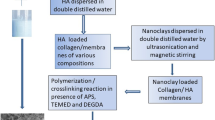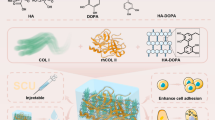Abstract
In the effort to generate cartilage tissues using mesenchymal stem cells, porous scaffolds with prescribed biomechanical properties were prepared. Scaffolds with interconnected pores were prepared via lyophilisation of frozen hydrogels made from collagen modified with chitosan nanofibres, hyaluronic acid, copolymers based on poly(ethylene glycol) (PEG), poly(lactic-co-glycolic acid) (PLGA), and itaconic acid (ITA), and hydroxyapatite nanoparticles. The modified collagen compositions were cross-linked using N-(3-dimethylamino propyl)-N′-ethylcarbodiimide hydrochloride (EDC) combined with N-hydroxysuccinimide (NHS) in water solution. Basic physicochemical and mechanical properties were measured and an attempt to relate these properties to the molecular and supermolecular structure of the modified collagen compositions was carried out. Scaffolds containing hydrophilic chitosan nanofibres showed the highest swelling ratio (SR = 20–25) of all the materials investigated, while collagen modified with an amphiphilic PLGA-PEG-PLGA copolymer or functionalised with ITA exhibited the lowest swelling ratio (SR = 5–8). The best resistance to hydrolytic degradation was obtained for hydroxyapatite containing scaffolds. On the other hand, the fastest degradation rate was observed for synthetic copolymer-containing scaffolds. The results showed that the addition of hydroxyapatite or hyaluronic acid to the collagen matrix increases the rigidity in comparison to the collagen-chitosan scaffold. Collagen scaffold modified with hyaluronic acid presented reduced deformation at break while the presence of hydroxypatatite enhanced the scaffold deformation under tensile loading. The tensile elastic modulus of chitosan nanofibre collagen scaffold was the lowest but closest to the articular cartilage; however, the strength and deformation to failure increased up to 200 %.
Similar content being viewed by others
References
Cancedda, R., Dozin, B., Giannoni, P., & Quarto, R. (2003). Tissue engineering and cell therapy of cartilage and bone. Matrix Biology, 22, 81–91. DOI: 10.1016/S0945-053X(03) 00012-X.
Damink, L. H. H. O., Dijkstra, P. J., van Luyn, M. J. A., van Wachem, P. B., Nieuwenhuis, P., & Feijen, J. (1996). Crosslinking of dermal sheep collagen using a water-soluble carbodiimide. Biomaterials, 17, 765–773. DOI: 10.1016/0142-9612(96)81413-X.
Freyman, T. M., Yannas, I. V. & Gibson, L. J. (2001). Cellular materials as porous scaffolds for tissue engineering. Progress in Materials Science, 46, 273–282. DOI: 10.1016/S0079-6425(00)00018-9.
Friess, W. (1998). Collagen — biomaterial for drug delivery. European Journal of Pharmaceutics and Biopharmaceutics, 45, 113–136. DOI: 10.1016/S0939-6411(98)00017-4.
Martin, R. B., Burr, D. B., & Sharkey, N. A. (1998). Skeletal tissue mechanics. New York: Springer.
Park, S. N., Lee, H. J., Lee, K. H. & Suh, H. (2003). Biological characterization of EDC-crosslinked collagen-hyaluronic acid matrix in dermal tissue restoration. Biomaterials, 24, 1631–1641. DOI: 10.1016/S0142-9612(02)00550-1.
Sato, T, Chen, G., Ushida, T., Ishii, T., Ochiai, N., Tateishi, T., & Tanaka, J. (2004). Evaluation of PLLA-collagen hybrid sponge as a scaffold for cartilage tissue engineering. Materials Science and Engineering: C, 24, 365–372. DOI: 10.1016/j.msec.2003.12.010.
Schwartz, M. H., Leo, P. H. & Lewis, J. L. (1994). A microstructural model for the elastic response of articular cartilage. Journal of Biomechanics, 27, 865–873. DOI: 10.1016/0021-9290(94)90259-3.
Suh, H, & Lee, J.-E. (2002). Behavior of fibroblasts on a porous hyaluronic acid incorporated collagen matrix. Yonsei Medical Journal, 43, 193–202.
Author information
Authors and Affiliations
Corresponding author
Rights and permissions
About this article
Cite this article
Sloviková, A., Vojtová, L. & Jančař, J. Preparation and modification of collagen-based porous scaffold for tissue engineering. Chem. Pap. 62, 417–422 (2008). https://doi.org/10.2478/s11696-008-0045-8
Received:
Revised:
Accepted:
Published:
Issue Date:
DOI: https://doi.org/10.2478/s11696-008-0045-8




